Categories
Archives
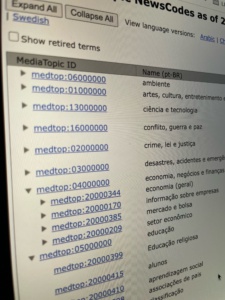
The IPTC NewsCodes Working Group is pleased to announce the latest release of the IPTC NewsCodes, our set of controlled vocabularies for the news industry.
Updates this time span many vocabularies, with the biggest updates to Media Topic and Digital Source Type.
Media Topic updates
Most of the recent work has been in the politics branch.
3 new concepts: by-election, recall election, coalition building
2 retired concepts: political campaigns, church elections
4 modified concept names (in English): voting system, referendum, fundamental rights, football (yes we finally refer to the sport as “football” in en-GB and “soccer” in en-US!)
Modified concept definitions: 22 civil rights, election, voting system, intergovernmental elections, local elections, primary elections, referendum, regional elections, voting, fundamental rights, censorship and freedom of speech, freedom of religion, freedom of the press, human rights, football, political debates, privacy, women’s rights, breaking (breakdance)
1 hierarchy move: fundamental rights has been moved from politics to society.
Also, the Wikidata mapping URIs have all been changed to point to the http:// version of the URI instead of the https:// version. This follows the official Wikidata guidance.
See the official Media Topic vocabulary on the IPTC Controlled Vocabulary server, and an easier-to-navigate tree view. An Excel version of IPTC Media Topics is also available.
Digital Source Type updates
5 new concepts have been added:
- Multi-frame computational capture sampled from real life, intended to cover media recorded by modern cameras and smartphones that may process several captured images together to create the saved media file, without any interaction with the photographer.
- Human-edited media, intended to replace the retired Original media with minor human edits, given that it is subjective to decide what is a “minor” edit.
- Digital creation, intended to replace the retired Digital art so that we can avoid the existential question of “what is art?”
- Screen capture, covering screenshots and screen recordings made on a device
- Composite of elements, as a generic form of the more specific “composite” terms.
2 concepts have been retired: Original media with minor human edits, and Digital art, as explained above.
8 concepts have had their names and definitions modified, while retaining the same machine-readable ID for backwards-compatibility purposes:
- Digital capture sampled from real life (ID: digitalCapture), replacing the previous name “Original digital capture sampled from real life”
- Digitised from a transparent negative (ID: negativeFilm), replacing the previous name “Digitised from a negative on film”
- Digitised from a transparent positive (ID: positiveFilm), replacing the previous name “Digitised from a positive on film”
- Digitised from a non-transparent medium (ID: print), replacing the previous name “Digitised from a print on non-transparent medium”
- Edited using Generative AI (ID: compositeWithTrainedAlgorithmicMedia), replacing the previous name “Composite with Trained algorithmic media”
- Algorithmically-altered media (ID: algorithmicallyEnhanced), replacing the previous name “Algorithmically Enhanced”
- Created using Generative AI (ID: trainedAlgorithmicMedia), replacing the previous name “Trained Algorithmic Media”
- Virtual event recording (ID: virtualRecording), replacing the previous name “Virtual recording”
Our thanks go to IPTC representatives and experts from Partnership on AI, Google, Adobe, C2PA, CIPA and many others on making these updates to our vocabulary, which is now widely used to identify Generative AI content.
Updates to other NewsCodes vocabularies
Alternative Identifier Role (altidrole)
- Vocabulary’s name changed to fix a spelling mistake.
- New concept: IPTC Video Metadata Hub ID (altidrole:vmhVideoId)
Event Occur Status (eocstat)
- Fix spelling mistake “occurence” -> “occurrence” throughout.
Golf Shot (spgolshot)
- New concept: Chip (spgolshot:chip)
Rights Property (rightsprop)
- New concept: Copyright Year (rightsprop:copyrightyear)
- 4 modified definitions: Minor Model Age Disclosure, Model Release Id, Model Release Status, Property Release Status.
Sports Concept (spct)
- New concept: Recurring Competition (spct:recurring-competition)
- New concept: Governing Body (spct:governing-body)
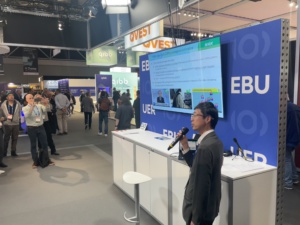
Over a weekend in mid-September every year, Europe’s (and increasingly the world’s) broadcast media industry gets together at IBC, the International Broadcasting Convention.
IPTC members were well represented at this year’s event:
- IPTC Startup Members Factiverse were out in full force promoting their automated fact-checking solution, which can now be integrated into any media asset management tool via an API.
- Fellow Startup Members HAND – Human & Digital presented their work on an IBC Accelerator project looking at called “Digital Replicas and Talent ID: Provenance, Verification and New Automated Workflows” along with Paramount, ITV, EZDRM and The Scan Truck.
- Moments Lab (previously known as Newsbridge) presented their video segmentation and annotation systems on a very well attended stand.
- The BBC featured in many sessions. Judy Parnall, lead of IPTC’s Media Provenance Committee’s Advocacy and Education Working Group, presented two papers, both concerning the BBC’s work with C2PA, leading to the BBC’s work with Project Origin and the IPTC Media Provenance Committee. One was presented along with new IPTC Individual Member, John Simmons.
- Newly upgraded to IPTC Voting Members, he European Broadcasting Union (EBU) had a very popular stand demonstrating several accelerator projects, including the best demonstrator of C2PA we have yet seen: an end-to-end workflow from a Content Credential-enabled Leica camera, along with AI-generated content from Adobe Firefly, edited in Adobe Premiere Pro, and published using WDR’s publisher certificate which is on the new IPTC Verified News Publisher list. IPTC Managing Director Brendan Quinn gave a short presentation at the EBU stand’s C2PA meet-up event, explaining the IPTC’s recently-announced work on the Verified News Publisher List. Other speakers at the meet-up were Kenneth from WDR, Andy Parsons from Adobe and the Content Authenticity Initiative, Go Ohtake of NHK (who demonstrated a prototype C2PA application running on a Web TV platform), and project lead Lucille Verbaere of the EBU.
- Media Cluster Norway (previously known as Media City Bergen) ran an awesome breakfast event about Project Reynir, their project to make Norway’s media ecosystem a pathfinder for C2PA technology from one end of the production workflow to the other, including vendors such as VizRT and Wolftech, Norwegian news agency NTB and more.
- Liaison partner The DPP had a great reception where the industry came together to discuss future projects including the Live Production Exchange project on which IPTC is assisting via our News in JSON (ninjs) Working Group.
- Of course Adobe and Google both had enormous and well attended stands, Associated Press and Reuters were receiving a lot of attention (particular after Reuters’ acquisition of digital content management company Imagen last year). Arqiva and Broadcast Solutions were also represented with well-attended stands.
From what we could see, all IPTC members who attended the convention had a very successful time, and we look forward to many future successful events.
We hope to see all of you again at the IPTC Autumn Meeting next week!
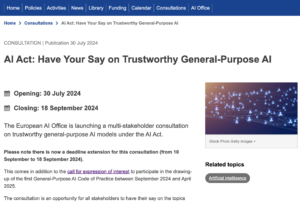 The IPTC has responded to a multi-stakeholder consultation on the recently-agreed European Union Artificial Intelligence Act (EU AI Act).
The IPTC has responded to a multi-stakeholder consultation on the recently-agreed European Union Artificial Intelligence Act (EU AI Act).
Although the IPTC is officially based in the UK, many of our members and staff operate from the European Union, and of course all of our members’ content is available in the EU, so it is very important to us that the EU regulates Artificial Intelligence providers in a way that is fair to all parts of the ecosystem, including content rightsholders, AI providers, AI application developers and end users.
In particular, we drew the EU AI Office’s attention to the IPTC Photo Metadata Data Mining property, which enables rightsholders to inform web crawlers and AI training systems of the rightsholders’ agreement as to whether or not the content can be used as part of a training data set for building AI models.
The points made are the same as the ones that we made to the IETF/IAB Workshop consultation: that embedded data mining declarations should be part of the ecosystem of opt-outs, because robots.txt, W3C TDM, C2PA and other solutions are not sufficient for all use cases.
The full consultation text and all public responses will be published by the EU in due course via the consultation home page.
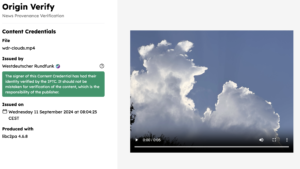
AMSTERDAM, 13 September 2024 — The International Press Telecommunications Council (IPTC) has announced Phase 1 of the IPTC Verified News Publishers List at the International Broadcast Convention (IBC).
The list uses C2PA technology to enable verified provenance for the news media industry. News outlets apply for a certificate from a partner Certificate Authority (currently Truepic), with the IPTC verifying the identity of the publisher. The certificate is then used by the news outlet to sign content, in accordance with the C2PA specification’s handling of “additional trust anchor stores”. This means that the news publisher is the signer of the content. This is a key requirement for many media outlets.
Currently the BBC (UK), CBC / Radio Canada (Canada) and broadcaster WDR (Germany) have certificates on the Verified News Publishers List. Many more publishers and broadcasters are currently in the process of obtaining a certificate. To register your interest as a news publisher, please fill out the Verified News Publisher expression of interest form.
To make the process of verifying and approving certificate requests transparent and accountable, the IPTC has released a set of policies for issuing Verified News Publisher certificates covering Phase 1 of the project. The process includes a “fast track” process for media organisations that are already well known to IPTC, and also a self-certification track. The policies were approved by the IPTC membership at a recent meeting of the IPTC Media Provenance Committee.
Verifying publisher identity, not trustworthiness
Note: as we have always made clear, the IPTC is making no claims about the truth or trustworthiness of content published by news publishers on the IPTC Verified News Publisher List. We simply verify that the publisher is “who they say they are”, and then the signature will verify that the content was published by that publisher, and has not been tampered with since the point of publishing.
We make it clear in the governance policies that a certificate can be revoked if the certificate’s private key has been compromised in some way, but we will not revoke certificates for editorial reasons.
Online verifier tool
The IPTC has worked with the BBC to launch a simple Verified News Publisher content verifier tool hosted at https://originverify.iptc.org. The tool displays a special indicator when content has been signed by an organisation whose certificate is on the Verified News Publisher list. The IPTC has also published a set of Verified News Publisher sample content that can be used with the verifier to demonstrate the process in action.
Sharing best practices, resources and knowledge among news publishers
For IPTC members, the Media Provenance Committee has created an internal members-only wiki detailing best practices and lessons learned while implementing C2PA and the Verified News Publisher List at broadcasters and publishers. Information on the wiki includes technical details on how to generate a certificate signing request to obtain a certificate, how to sign content with open-source and commercial tools, how to deal with publishing and distribution technology such as streaming servers and content delivery networks, and how to add metadata to C2PA assertions embedded in media content.
The Committee has also created a public-facing area of the IPTC site describing IPTC’s work in the area of Media Provenance, helping news publishers to get up to speed and understand how C2PA technology works and how it can be implemented in publishing workflows.
Other IPTC and Media Provenance-related events at IBC this weekend:
- Judy Parnall (BBC), Lead of the IPTC Media Provenance Advocacy Working Group, spoke on a panel on “Content Tracing and Provenance” this morning (Friday) at the AI Zone.
- Judy is also presenting a paper at the IBC Conference on Saturday 14 September: Provenance: What can we Trust?, along with IPTC Individual Member John Simmons.
- Combating disinformation in News: A critical year for democracies at the IPTC Conference on Saturday. Laura Ellis (BBC) is on the panel along with representatives from CBS and GLOBO.
- On Sunday 15 September, Judy presents IBC’s Accelerator Project “Design Your Weapons in Fight Against Disinformation” on the IBC Innovation Stage, along with tech leaders from CBS, Associated Press and ITN.
The IPTC is excited to announce that the IPTC Autumn Meeting 2024 is fast approaching, taking place from Monday September 30 to Wednesday October 2. This year’s event will be held virtually, providing IPTC members with the opportunity to stay informed and connected with industry leaders, no matter their location.
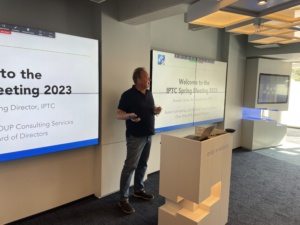
The Autumn Meeting will focus on the latest innovations in news metadata, standards, and tools that are shaping the future of digital content and journalism.
One of the key highlights of the meeting will be presentations by IPTC’s various Working Groups. These sessions will dive deep into advancements in metadata standards, addressing challenges like improving interoperability and adapting to the rapid rise of artificial intelligence in media.
Another focal point of the event will be updates on how new and existing IPTC standards like NewsML-G2, ninjs, Video Metadata Hub are helping news and media organisations to streamline the exchange of information. These tools play a critical role in ensuring that news content is delivered in a trusted and structured manner across platforms.
In addition to the technical presentations, the meeting will also feature case studies from IPTC member organizations. These will explore innovative uses of IPTC standards, such as the DPP Live Production Exchange project and the TEMS Trusted European Media Data Space.
The new IPTC Media Provenance Committee will come together to present to IPTC members recent activity in the working groups on Governance, Best Practices and Advocacy & Education around implementing media provenance technologies such as C2PA in newsrooms and media publishing workflows. We will hear from members such as CBC / Radio Canada on how these standards are helping media companies tackle issues like misinformation and content verification.
The event also includes the official IPTC Annual General Meeting (AGM), where Voting Members will participate in elections for the IPTC Board of Directors and vote on important decisions regarding the management of IPTC. The AGM is a great opportunity for members to shape the future direction of IPTC and its work on evolving industry standards.
The IPTC Standards Committee will meet to vote on proposed new standards from several working groups, including new versions of ninjs, NewsML-G2 and IPTC Sport Schema.
As always, registration for the IPTC Autumn Meeting is free for IPTC members. It’s an unmissable chance to engage with cutting-edge developments in the industry and collaborate with fellow professionals committed to improving news and media standards worldwide.
For more information and to register, visit IPTC Autumn Meeting 2024.
Categories
Archives
- December 2025
- November 2025
- October 2025
- September 2025
- August 2025
- July 2025
- June 2025
- May 2025
- April 2025
- March 2025
- February 2025
- January 2025
- December 2024
- November 2024
- October 2024
- September 2024
- August 2024
- July 2024
- June 2024
- May 2024
- April 2024
- March 2024
- February 2024
- December 2023
- November 2023
- October 2023
- September 2023
- August 2023
- July 2023
- June 2023
- May 2023
- March 2023
- February 2023
- January 2023
- December 2022
- November 2022
- October 2022
- September 2022
- August 2022
- July 2022
- June 2022
- May 2022
- April 2022
- March 2022
- February 2022
- January 2022
- December 2021
- November 2021
- October 2021
- September 2021
- August 2021
- July 2021
- June 2021
- May 2021
- April 2021
- February 2021
- December 2020
- November 2020
- October 2020
- September 2020
- August 2020
- July 2020
- June 2020
- May 2020
- April 2020
- March 2020
- February 2020
- December 2019
- November 2019
- October 2019
- September 2019
- July 2019
- June 2019
- May 2019
- April 2019
- February 2019
- November 2018
- October 2018
- September 2018
- August 2018
- July 2018
- June 2018
- May 2018
- April 2018
- March 2018
- January 2018
- November 2017
- October 2017
- September 2017
- August 2017
- June 2017
- May 2017
- April 2017
- December 2016
- November 2016
- October 2016
- September 2016
- August 2016
- July 2016
- June 2016
- May 2016
- April 2016
- February 2016
- January 2016
- December 2015
- November 2015
- October 2015
- September 2015
- June 2015
- April 2015
- March 2015
- February 2015
- November 2014